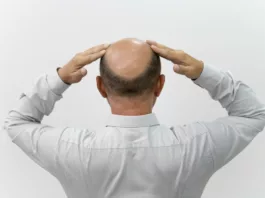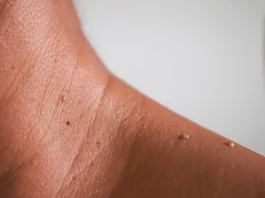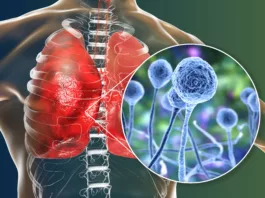Chronic Telogen Effluvium (CTE) is a common form of diffuse, non-scarring alopecia characterized by excessive hair shedding that persists for more than six months. It typically affects middle-aged women who previously had normal hair density. The condition often follows a triggering event such as emotional stress, childbirth, major surgery, chronic illness, or nutritional deficiency. Unlike androgenetic alopecia, CTE does not cause miniaturization of hair follicles, and hair density may fluctuate over time. Although CTE does not lead to complete baldness, it can cause significant emotional distress, and patients often benefit from reassurance, supportive care, and identification of reversible triggers.
What happens in Chronic Telogen Effluvium?
Understanding the Normal Hair Cycle:
Our scalp contains about a hundred thousand hair follicles at a given time. These hair follicles divide asynchronously in three phases:
- Anagen Phase: It’s the hair follicle’s main mitotic phase, typically lasting 2 to 6 years in one cycle. In the anagen phase, matrix keratinocytes in your hair bulb divide rapidly, causing the hair to elongate. About 85 to 90% of all hair on the scalp is normally in this phase at a given time.1Lin, X., Zhu, L., & He, J. (2022). Morphogenesis, Growth Cycle, and Molecular Regulation of Hair Follicles. Frontiers in Cell and Developmental Biology, 10, 899095. https://doi.org/10.3389/fcell.2022.899095
- Catagen Phase: This phase lasts for about 2 to 3 weeks. In this phase, the lower part of the hair follicle undergoes apoptosis-mediated regression. About 1-3% of the hair follicles exist in the catagen phase. 2Lin, X., Zhu, L., & He, J. (2022). Morphogenesis, Growth Cycle, and Molecular Regulation of Hair Follicles. Frontiers in Cell and Developmental Biology, 10, 899095. https://doi.org/10.3389/fcell.2022.899095
- Telogen Phase: It is the resting and shedding phase of your hair follicles. In the telogen phase, the hair follicle becomes inactive, and mitotic division stops. About 5-10% of your total hair is in this phase at any time. This phase spans about 3-4 months.3Lin, X., Zhu, L., & He, J. (2022). Morphogenesis, Growth Cycle, and Molecular Regulation of Hair Follicles. Frontiers in Cell and Developmental Biology, 10, 899095. https://doi.org/10.3389/fcell.2022.899095
Once this phase ends, new anagen hair grows beneath the old telogen hair and pushes the telogen hair out of the follicle. According to this physiology, shedding 50-100 telogen hairs per day is normal.
Pathophysiology of Chronic Telogen Effluvium:
Chronic Telogen Effluvium is the dysregulation of your hair cycle. When local or systemic stressors interfere with your normal hair cycle, they cause a greater-than-usual number of your hair to arrest in the telogen phase. This leads to increased hair shedding and diffuse thinning across the scalp.4Hughes EC, Syed HA, Saleh D. Telogen Effluvium. [Updated 2024 May 1]. In: StatPearls [Internet]. Treasure Island (FL): StatPearls Publishing; 2025 Jan-. Available from: https://www.ncbi.nlm.nih.gov/books/NBK430848/
Acute Telogen Effluvium Vs Chronic Telogen Effluvium
The key difference between acute and chronic telogen effluvium lies in their duration. Acute cases last under six months and usually resolve on their own, while chronic TE continues for longer and needs deeper evaluation.
| Feature | Acute Telogen Effluvium (ATE) | Chronic Telogen Effluvium (CTE) |
| Onset | Sudden and abrupt hair shedding | Gradual and insidious onset |
| Duration | Less than 6 months | Persists beyond 6 months |
| Triggering Event | Identifiable acute stressor (e.g., febrile illness, surgery, postpartum state) | Often idiopathic or linked to chronic stressors or systemic conditions |
| Pattern of Hair Loss | Diffuse thinning, most noticeable on the vertex | Generalized thinning across the entire scalp without distinct bald patches |
| Severity of Shedding | Acute and prominent shedding | Mild to moderate, but persistent shedding |
| Hair Regrowth | Spontaneous regrowth typically occurs within 3–6 months | Regrowth may be delayed or inconsistent |
| Demographics | Affects all age groups; frequently postpartum females | Common in women aged 30–60 years |
What Causes Chronic Telogen Effluvium?
Any form of stress or factors that may disrupt the normal hair cycle cause CTE. These identifiable causes include:
Stress:
Chronic psychological or emotional stress dysregulates our Hypothalamus-Pituitary-Adrenal (HPA) axis, impacting the hair follicle cycle. When in stress, our bodies release corticotropin-releasing hormone (CRH) from the hypothalamus, as well as locally within the hair follicle’s microenvironment.
Evidence suggests that CRH inhibits autophagy (self-destruction for reuse) in dermal papilla cells (skin cells that produce hair). This causes the hair follicle to prematurely enter the catagen phase, and prolong the telogen phase, contributing to hair loss.5Liang, W., Zhao, Y., Cai, B., Huang, Y., Chen, X., Ni, N., Wang, Y., Lin, Z., Lin, C., & Huang, K. (2024). Psychological stress induces hair regenerative disorders through corticotropin-releasing hormone-mediated autophagy inhibition. Biochemical and biophysical research communications, 699, 149564. https://doi.org/10.1016/j.bbrc.2024.149564
Chronic Illness:
Chronic illnesses also disrupt the normal hair cycle, triggering CTE.
- Thyroid Disorders: Hypothyroidism prolongs the telogen phase, whereas hyperthyroidism speeds up the hair cycle and causes hair to enter the telogen phase prematurely. A retrospective study found that approximately 33% of individuals with hypothyroidism and around 50% of those with hyperthyroidism experience diffuse telogen hair shedding.6Hasan, R., Juma, H., Eid, F. A., Alaswad, H. A., Ali, W. M., & Aladraj, F. J. (2022). Effects of Hormones and Endocrine Disorders on Hair Growth. Cureus, 14(12), e32726. https://doi.org/10.7759/cureus.32726
- Autoimmune Disorders: Disorders like Systemic Lupus Erythematosus (SLE) and Rheumatoid Arthritis impact your hair cycle due to systemic inflammation and immune-mediated damage to the hair follicle.
- Chronic Infections: Chronic infections like Tuberculosis and HIV trigger CTE by inducing systemic inflammation, increasing physiological stress, and leading to secondary nutritional deficiencies.
Nutritional Deficiency:
Our hair follicles need specific nutrients for growth and nourishment. Deficiency of these nutrients affects the proliferation of hair cells.
- Iron: We require iron for DNA synthesis and hair cell growth. Iron deficiency, especially serum ferritin, is closely associated with telogen effluvium. A study reports that nearly half of telogen effluvium patients have low ferritin, linking iron deficiency to hair loss.7Cheung, E. J., Sink, J. R., & English Iii, J. C. (2016). Vitamin and Mineral Deficiencies in Patients With Telogen Effluvium: A Retrospective Cross-Sectional Study. Journal of drugs in dermatology: JDD, 15(10), 1235–1237.
- Protein: Since our hair is primarily composed of protein, such as keratin, a low protein intake also disrupts the normal hair cycle. It does so by making our hair follicles enter the telogen phase earlier than normal.8Guo, E. L., & Katta, R. (2017). Diet and hair loss: effects of nutrient deficiency and supplement use. Dermatology practical & conceptual, 7(1), 1–10. https://doi.org/10.5826/dpc.0701a01
- Zinc, Vitamin D, Vitamin B12: These minerals are also essential for your hair growth and hormonal regulation. Deficiency of these nutrients weakens the hair and triggers CTE.
Hormonal Imbalance:
Such as in:
- Postpartum: During pregnancy, elevated estrogen levels prolong the anagen phase. But after delivery, when these levels decline, a significant number of hair follicles enter the telogen phase. Research suggests that prolonged breastfeeding and preterm labor may also increase postpartum hair loss.9Hirose, A., Terauchi, M., Odai, T., Fudono, A., Tsurane, K., Sekiguchi, M., Iwata, M., Anzai, T., Takahashi, K., & Miyasaka, N. (2023). Investigation of exacerbating factors for postpartum hair loss: A questionnaire-based cross-sectional study. International Journal of Women’s Dermatology, 9(2), e084. https://doi.org/10.1097/JW9.0000000000000084
- Menopause: Estrogen and progesterone, the female hormones, promote the anagen phase. As these hormones drop after menopause, the anagen phase is shortened. Research highlights that menopause-related hormonal changes disrupt the hair cycle, often causing telogen effluvium and female pattern hair loss.10Kamp, E., Ashraf, M., Musbahi, E., & DeGiovanni, C. (2022). Menopause, skin, and common dermatoses. Part 1: Hair disorders. Clinical and Experimental Dermatology, 47(12), 2110-2116. https://doi.org/10.1111/ced.15327
- Polycystic Ovary Syndrome (PCOS): In PCOS, your androgen hormone levels rise. Androgen binds to receptors in the hair follicle and decreases the anagen phase duration.
Drugs:
These include:
- Beta Blockers: These reduce the sympathetic nervous system activity by blocking the beta-adrenergic receptors. These receptors are also present in hair follicles for cell proliferation. Blockage of these receptors halts hair cell division.
- Retinoids: High doses of retinoids arrest the hair follicle in the telogen phase.
- Anticoagulants (Heparin, Warfarin): These are blood-thinning drugs that impair microvascular circulation and nutrient supply to the hair follicles.
- Chemotherapy: Secondary to the stress of chemotherapy, some patients might experience a combination of anagen effluvium and telogen effluvium.
Other Factors:
- Recent major surgery or physical trauma
- Rapid weight loss
Who is at Risk?
Although anyone can get Telogen Effluvium, these groups are more prone to it:
- Middle-Aged Women: Secondary to hormonal fluctuations, chronic stress, and nutrient deficiencies
- Postpartum Mothers: Acute hair fall in mothers is common after childbirth. In some cases, it may persist for more than six months.
- People suffering from chronic stress
- Vegans with protein and nutrient deficiencies
- Patients with chronic diseases
- Patients on chemotherapy
- People using medications known to cause hair loss
Symptoms of Chronic Telogen Effluvium
The symptoms of CTE include:
- Diffuse Hair Shedding: Chronic Telogen Effluvium doesn’t cause your hair to fall from one area of the scalp. It usually involves the whole scalp evenly.
- Prolonged & Fluctuating Hair Loss: According to the American Academy of Dermatology (AADO), you may notice ongoing hair loss longer than six months, which might wax and wane in severity.
- Abrupt Hair Fall: Hair fall in CTE begins gradually and may remain unnoticed for weeks or even months. But there may be a sudden increase in shedding, often following a trigger (e.g, an illness, stress, or postpartum).
- Absence of Inflammatory Symptoms: There may not be any symptoms of inflammation in CTE, such as itching, scaling, flaking, or redness on the scalp.
- Normal Hair Regrowth: Despite the hair fall, you might observe new hair growth. This is because in the background, the hair cycle is intact– it’s just misregulated.
How Common Is Chronic Telogen Effluvium?
The exact prevalence of CTE is unknown because it usually remains underdiagnosed. Many cases of CTE are misclassified as acute telogen effluvium (ATE) or female pattern hair loss (FPHL).
Another reason is that many people don’t seek medical help as long as they have visible hair coverage. But epidemiologists believe that it’s quite common. Studies suggest that it affects many adults at some point in their lives.11Seyfi, S., Alijanpour, R., Aryanian, Z., Ezoji, K., & Mahmoudi, M., 2022). Prevalence of telogen effluvium hair loss in COVID-19 patients and its relationship with disease severity. Journal of medicine and life, 15(5), 631–634.
Also, it’s one of the most common causes of hair shedding in women. Chronic telogen effluvium (CTE) is seen in approximately 30% of women in the USA, UK, and Japan.12Rushton, D. H., Norris, M. J., Dover, R., & Busuttil, N. (2002). Causes of hair loss and the developments in hair rejuvenation. International journal of cosmetic science, 24(1), 17–23. https://doi.org/10.1046/j.0412-5463.2001.00110.x
This is partly due to the hormonal changes, and partly because women take hair loss more seriously and seek medical attention more proactively as compared to men.13Motosko, C. C., Bieber, A. K., Pomeranz, M. K., Stein, J. A., & Martires, K. J. (2017). Physiological changes of pregnancy: A review of the literature. International journal of women’s dermatology, 3(4), 219–224. https://doi.org/10.1016/j.ijwd.2017.09.003
Is Chronic Telogen Effluvium the same as Androgenetic Alopecia?
No, CTE and Androgenetic alopecia are two different entities, with distinct causes, patterns, and treatments. Their key differences are listed in the table below:
| Feature | Chronic Telogen Effluvium | Androgenetic Alopecia |
| Onset | Begins suddenly and shows a noticeable increase in hair shedding | Begins gradually, causing progressive thinning over time |
| Duration | Persists longer than 6 months | Chronic and progressive without treatment |
| Pattern of Hair Loss | Diffuse thinning across the whole scalp | Patterned thinning typically affects the crown and temples in men, and the central scalp in women |
| Hair Shedding | Daily hair shedding is more than 100 strands | Normal or slightly increased shedding. Miniaturization of hair follicles occurs |
| Hair Shaft Diameter | Uniform hair shaft across the whole diameter | Miniaturization causes a variation in hair shaft diameter |
| Scalp Examination | Normal scalp appearance without inflammation or scarring | Signs of miniaturized follicles. Shiny scalp in advanced stages |
| Triggers | Often associated with stress, illness, hormonal changes, or nutritional deficiencies | Associated with genetic predisposition and influenced by androgens |
| Reversibility | Often reversible with the removal of the trigger or treatment | Management can slow progression but not fully reverse it |
| Diagnostic Tools | Positive hair pull test, trichogram shows increased telogen hairs | Miniaturized hairs on trichoscopy, Scalp Biopsy confirms the diagnosis |
| Treatment Approach | By addressing the underlying cause, nutritional support, and stress management | Use of topical minoxidil, oral finasteride (in men), low-level laser therapy, and hair transplantation in advanced cases |
How to Diagnose Chronic Telogen Effluvium?
The diagnosis of CTE is predominantly clinical. Your healthcare provider uses a combination of history and examination to rule out the differentials and confirm the diagnosis of CTE.
Medical History:
Your physician may inquire about:
- Patterns and duration of hair loss.
- Recent illnesses, surgeries, or other significant life events like childbirth or major stressors occurring 2–3 months before hair shedding.
- Dietary habits, including any recent changes or deficiencies.
- Medications taken in the past few months.
Physical Examination:
Then, the doctor might examine your scalp for:
- Diffuse thinning without scarring.
- The presence of short, regrowing hairs indicates recovery.
Hair Pull Test:
This simple test involves gently pulling a small section of your scalp hair (about 40–60 strands at a time). In a healthy scalp, there is shedding of hardly 2-3 hairs in a hair pull test. But in CTE, more than 4–6 hairs may come out, each with a white bulb at the root, signifying telogen phase hairs.
Trichoscopy:
Trichoscopy is a non-invasive tool used to examine your scalp and hair under magnification. In chronic telogen effluvium (CTE), trichoscopy may show a uniform hair diameter without miniaturization, which helps differentiate it from androgenetic alopecia.
Laboratory Tests:
Telogen effluvium is diagnosed clinically. However, lab tests can help find any underlying medical issues, like nutrient deficiencies or hormonal imbalances. Your doctor might ask you to get these labs done:
- Complete Blood Count (CBC): to check for anemia.
- Serum Ferritin: to assess iron stores; low levels can be linked to CTE.
- Thyroid Function Tests: to rule out hypothyroidism or hyperthyroidism.
Differential Diagnosis of Chronic Telogen Effluvium
CTE can be confused with other hair loss conditions, such as:
Androgenetic Alopecia:
- Gradual, patterned hair thinning
- Miniaturized hairs are visible on trichoscopy.
- More common in specific scalp regions (e.g., crown and frontal areas)
Alopecia Areata:
- Also called Diffuse Alopecia Areata
- Sudden, patchy hair loss
- Presence of “exclamation mark” hairs on trichoscopy
- Autoimmune origin
Anagen Effluvium:
- Rapid hair loss during the active hair growth phase
- Often caused by chemotherapy or toxic exposure.
- Hair loss occurs within days to weeks of the trigger.
Acute Telogen Effluvium:
- Hair shedding lasting less than 6 months
- Usually triggered by a recent stressor or illness.
- Differs from CTE, which lasts longer than 6 months
Scarring (Cicatricial) Alopecia:
- Commonly seen in conditions like Lichen planopilaris
- Permanent hair loss due to follicle destruction
- Signs of inflammation and scalp scarring
- Hair follicles are replaced by scar tissue
How do you treat Chronic Telogen Effluvium?
The treatment of Chronic telogen effluvium focuses on fixing the root cause, whether it is stress, nutritional deficiency, or hormonal imbalance.
Treating the Underlying Cause:
- Mindfulness, meditation, and stress-management techniques for chronic stress or emotional trauma
- Supplements & diet to correct nutritional deficiencies (iron, vitamin D, zinc, biotin, etc.)
- Hormonal treatment for imbalances like PCOS or menopause-related issues
- Levothyroxine for hypothyroidism
- Anti-thyroid medication for hyperthyroidism
- Medication review and replacement if your doctor suspects drug-induced hair loss
Pharmacological Treatment:
There are no FDA-approved drugs that specifically target CTE, but some off-label treatments have shown promising results. These include:
- Minoxidil: It is a vasodilator that improves hair density by prolonging the anagen phase. For CTE, doctors prescribe the oral form, whereas the topical form is commonly used to treat both female pattern hair loss and male pattern baldness.14 Perera, E., & Sinclair, R. (2017). Treatment of chronic telogen effluvium with oral minoxidil: A retrospective study. F1000Research, 6, 1650. https://doi.org/10.12688/f1000research.11775.1
- Other options that are still being investigated as potential treatments for CTE include Botox, platelet-rich plasma (PRP), and multivitamin mesotherapy.
General Supportive Hair Care:
Along with managing the underlying cause, you need to take gentle hair care measures to improve hair health and further reduce hair loss:
- Avoid harsh chemical treatments like bleaching and hair drying.
- Use mild shampoos and avoid washing your hair excessively.
- Avoid hard brushing or combing when hair is wet.
Styling Techniques:
These include different ways to style your hair that may obscure the hair loss, such as:
- Opt for layered or textured haircuts that create the illusion of hair
- A side part may help camouflage the thinning better as compared to a straight middle part.
- Choose hairstyles like messy buns that make your hair appear fuller.
- Accessorize smartly with headbands, clip-in extensions, or scarves.
Reassurance & Patient Counselling:
Doctors should convey to their patients clearly and empathetically that:
- Although it’s distressing, the hair follicles aren’t damaged. CTE doesn’t cause complete baldness.
- Your hair cycle is intact. It’s just misregulated, which can be managed with a personalized treatment plan.
- Triggers such as stress, hormonal change, or illness are often present and can be reversed. Work to identify and avoid them.
- Recovery takes time, but eventually CTE resolves, often without any aggressive treatment. You just need to be patient and trust the process.
Psychological Support:
This includes:
- Acknowledging the emotional and mental distress
- Offering relevant support
- Refer to a mental health specialist if body image issues or unmanageable anxiety arise.
Recovery Time for Chronic Telogen Effluvium
Chronic Telogen Effluvium is a prolonged form of hair shedding, but it is usually reversible once the root cause is treated. CTE often lasts 6 months or longer. Once the underlying issue is resolved:
- Hair shedding usually slows down within 2–3 months.
- Visible hair regrowth begins about 3–6 months.
- Full recovery may take 9–12 months, depending on the duration of CTE and the individual’s hair growth cycle.
Can I prevent CTE?
Though CTE might not be entirely preventable due to its complex nature, you can potentially reduce the risk by taking the following measures:
- Stress management: Yoga, mindfulness, meditation, and journaling can help you manage your stress and reduce the likelihood of getting CTE.
- Eating a Balanced Diet: Ensure a balanced diet containing Iron, Zinc, Vitamin D, Biotin, and Protein for proper hair nourishment and growth.
- Avoiding Extreme Calorie Cuts: Crash dieting affects the hair cycle and triggers shedding.
Conclusion
Chronic Telogen Effluvium is a diffuse, reversible, non-scarring type of hair loss that often lasts longer than six months. It usually affects women more than men. Often following a triggering event like stress, it can also occur without an identifiable cause. Diagnosis of CTE is clinical but may require lab investigations to rule out underlying nutritional, hormonal, or systemic problems. Management involves correcting reversible causes, improving lifestyle factors, and providing psychological support to the patients.
Refrences
- 1Lin, X., Zhu, L., & He, J. (2022). Morphogenesis, Growth Cycle, and Molecular Regulation of Hair Follicles. Frontiers in Cell and Developmental Biology, 10, 899095. https://doi.org/10.3389/fcell.2022.899095
- 2Lin, X., Zhu, L., & He, J. (2022). Morphogenesis, Growth Cycle, and Molecular Regulation of Hair Follicles. Frontiers in Cell and Developmental Biology, 10, 899095. https://doi.org/10.3389/fcell.2022.899095
- 3Lin, X., Zhu, L., & He, J. (2022). Morphogenesis, Growth Cycle, and Molecular Regulation of Hair Follicles. Frontiers in Cell and Developmental Biology, 10, 899095. https://doi.org/10.3389/fcell.2022.899095
- 4Hughes EC, Syed HA, Saleh D. Telogen Effluvium. [Updated 2024 May 1]. In: StatPearls [Internet]. Treasure Island (FL): StatPearls Publishing; 2025 Jan-. Available from: https://www.ncbi.nlm.nih.gov/books/NBK430848/
- 5Liang, W., Zhao, Y., Cai, B., Huang, Y., Chen, X., Ni, N., Wang, Y., Lin, Z., Lin, C., & Huang, K. (2024). Psychological stress induces hair regenerative disorders through corticotropin-releasing hormone-mediated autophagy inhibition. Biochemical and biophysical research communications, 699, 149564. https://doi.org/10.1016/j.bbrc.2024.149564
- 6Hasan, R., Juma, H., Eid, F. A., Alaswad, H. A., Ali, W. M., & Aladraj, F. J. (2022). Effects of Hormones and Endocrine Disorders on Hair Growth. Cureus, 14(12), e32726. https://doi.org/10.7759/cureus.32726
- 7Cheung, E. J., Sink, J. R., & English Iii, J. C. (2016). Vitamin and Mineral Deficiencies in Patients With Telogen Effluvium: A Retrospective Cross-Sectional Study. Journal of drugs in dermatology: JDD, 15(10), 1235–1237.
- 8Guo, E. L., & Katta, R. (2017). Diet and hair loss: effects of nutrient deficiency and supplement use. Dermatology practical & conceptual, 7(1), 1–10. https://doi.org/10.5826/dpc.0701a01
- 9Hirose, A., Terauchi, M., Odai, T., Fudono, A., Tsurane, K., Sekiguchi, M., Iwata, M., Anzai, T., Takahashi, K., & Miyasaka, N. (2023). Investigation of exacerbating factors for postpartum hair loss: A questionnaire-based cross-sectional study. International Journal of Women’s Dermatology, 9(2), e084. https://doi.org/10.1097/JW9.0000000000000084
- 10Kamp, E., Ashraf, M., Musbahi, E., & DeGiovanni, C. (2022). Menopause, skin, and common dermatoses. Part 1: Hair disorders. Clinical and Experimental Dermatology, 47(12), 2110-2116. https://doi.org/10.1111/ced.15327
- 11Seyfi, S., Alijanpour, R., Aryanian, Z., Ezoji, K., & Mahmoudi, M., 2022). Prevalence of telogen effluvium hair loss in COVID-19 patients and its relationship with disease severity. Journal of medicine and life, 15(5), 631–634.
- 12Rushton, D. H., Norris, M. J., Dover, R., & Busuttil, N. (2002). Causes of hair loss and the developments in hair rejuvenation. International journal of cosmetic science, 24(1), 17–23. https://doi.org/10.1046/j.0412-5463.2001.00110.x
- 13Motosko, C. C., Bieber, A. K., Pomeranz, M. K., Stein, J. A., & Martires, K. J. (2017). Physiological changes of pregnancy: A review of the literature. International journal of women’s dermatology, 3(4), 219–224. https://doi.org/10.1016/j.ijwd.2017.09.003
- 14Perera, E., & Sinclair, R. (2017). Treatment of chronic telogen effluvium with oral minoxidil: A retrospective study. F1000Research, 6, 1650. https://doi.org/10.12688/f1000research.11775.1





